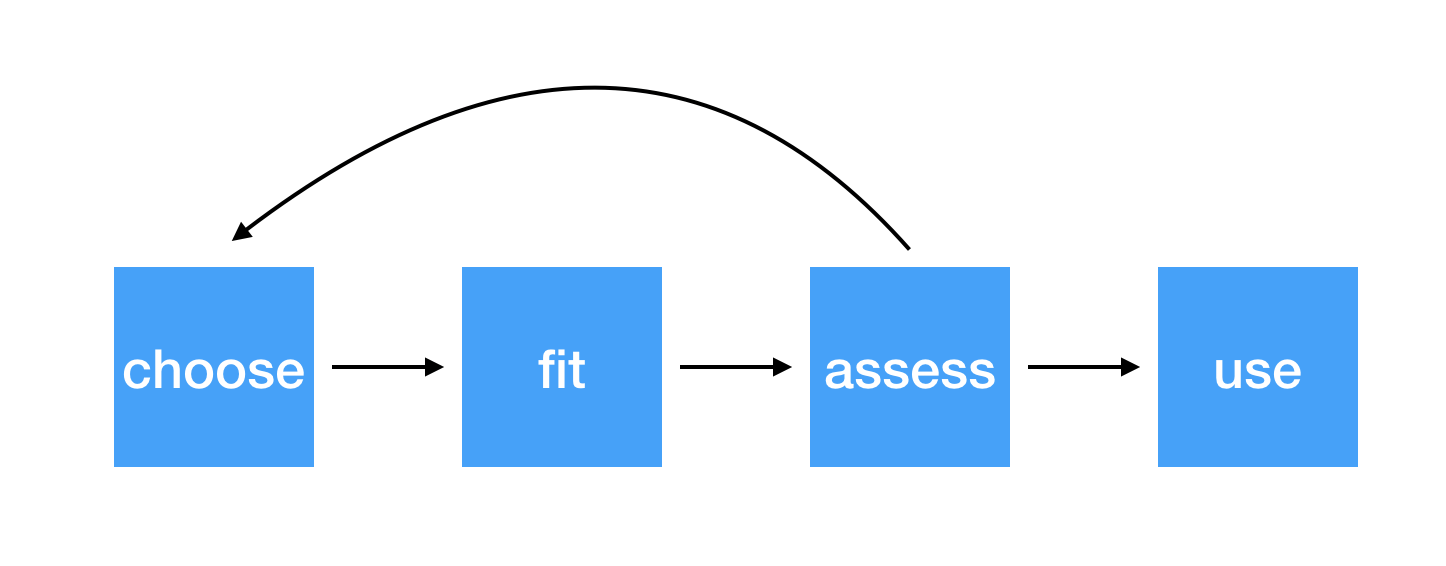Data transformations
Species Area
- Go to RStudio Cloud and open
Species Area
Steps for modeling

Steps for modeling

Conditions for simple linear regression
- Linearity
- Zero Mean
- Constant Variance
- Independence
- Random
- Normality
Conditions for simple linear regression
What can we do when these conditions aren't met?
- Linearity
- Zero Mean
- Constant Variance
- Independence
- Random
- Normality
transformations!
Example
Number of MDs and community hospitals for sample of 83 metropolitan areas
| City | NumMDs | NumHospitals |
|---|---|---|
| Holland-Grand Haven, MI | 349 | 3 |
| Louisville, KY-IN | 4042 | 18 |
| Battle Creek, MI | 256 | 3 |
| Madison, WI | 2679 | 7 |
| Fort Smith, AR-OK | 502 | 8 |
| Sarasota-Bradenton-Venice, FL | 2352 | 7 |
| Anderson, IN | 200 | 2 |
| Honolulu, HI | 3478 | 13 |
| Asheville, NC | 1489 | 5 |
| Winston-Salem, NC | 2018 | 6 |
Example
Number of MDs and community hospitals for sample of 83 metropolitan areas

Choose
Number of MDs and community hospitals for sample of 83 metropolitan areas
^Number of MDs=^β0+^β1Number of hospitals
Fit
Number of MDs and community hospitals for sample of 83 metropolitan areas
lm(NumMDs ~ NumHospitals, data = MetroHealth83)## ## Call:## lm(formula = NumMDs ~ NumHospitals, data = MetroHealth83)## ## Coefficients:## (Intercept) NumHospitals ## -385.1 282.0Fit
Number of MDs and community hospitals for sample of 83 metropolitan areas
Refresher: What is ^β0 and what does it mean?
lm(NumMDs ~ NumHospitals, data = MetroHealth83)## ## Call:## lm(formula = NumMDs ~ NumHospitals, data = MetroHealth83)## ## Coefficients:## (Intercept) NumHospitals ## -385.1 282.0Fit
Number of MDs and community hospitals for sample of 83 metropolitan areas
Refresher: What is ^β1 and what does it mean?
lm(NumMDs ~ NumHospitals, data = MetroHealth83)## ## Call:## lm(formula = NumMDs ~ NumHospitals, data = MetroHealth83)## ## Coefficients:## (Intercept) NumHospitals ## -385.1 282.0Assess
Number of MDs and community hospitals for sample of 83 metropolitan areas
What can I use to assess the linearity and constant variance assumptions?
Assess
Number of MDs and community hospitals for sample of 83 metropolitan areas
What can I use to assess the linearity and constant variance assumptions?

Assess
Number of MDs and community hospitals for sample of 83 metropolitan areas
What do you think?

Assess
Number of MDs and community hospitals for sample of 83 metropolitan areas
What can I use to assess the normality assumption?
Assess
Number of MDs and community hospitals for sample of 83 metropolitan areas
What do you think?

Assess
Number of MDs and community hospitals for sample of 83 metropolitan areas
What do you think?

Choose
- to stabilize the variance of the response ( y, in this case
NumMDs) across different values of the predictor ( x, in this caseNumHospitals), we can transform y or x
Choose
- to stabilize the variance of the response ( y, in this case
NumMDs) across different values of the predictor ( x, in this caseNumHospitals), we can transform y or x - typical transformations:
- √y
- logy
- x2
- 1/x
Choose
- to stabilize the variance of the response ( y, in this case
NumMDs) across different values of the predictor ( x, in this caseNumHospitals), we can transform y or x - typical transformations:
- √y
- logy
- x2
- 1/x
- For count data, such as the number of doctors or hospitals where the variability increases along with the magnitudes of the variables, a square root transformation is often helpful
Choose
Number of MDs and community hospitals for sample of 83 metropolitan areas
^√Number of MDs=^β0+^β1Number of hospitals
Fit
Number of MDs and community hospitals for sample of 83 metropolitan areas
lm(sqrt(NumMDs) ~ NumHospitals, data = MetroHealth83)## ## Call:## lm(formula = sqrt(NumMDs) ~ NumHospitals, data = MetroHealth83)## ## Coefficients:## (Intercept) NumHospitals ## 14.033 2.915Assess

Assess


Use
Number of MDs and community hospitals for sample of 83 metropolitan areas
^√Number of MDs=^β0+^β1Number of hospitals
^Number of MDs=(^β0+^β1Number of hospitals)2
Use
^Number of MDs=(^β0+^β1Number of hospitals)2
## ## Call:## lm(formula = sqrt(NumMDs) ~ NumHospitals, data = MetroHealth83)## ## Coefficients:## (Intercept) NumHospitals ## 14.033 2.915## City NumMDs NumHospitals## 1 Louisville, KY-IN 4042 18Use
^Number of MDs=(^β0+^β1Number of hospitals)2
## ## Call:## lm(formula = sqrt(NumMDs) ~ NumHospitals, data = MetroHealth83)## ## Coefficients:## (Intercept) NumHospitals ## 14.033 2.915## City NumMDs NumHospitals## 1 Louisville, KY-IN 4042 18(14.033 + 2.915 * 18)^2## [1] 4422.649Use

Species Area
- Go to RStudio Cloud and open
Species Area - For each question you work on, set the
evalchunk option toTRUEand knit